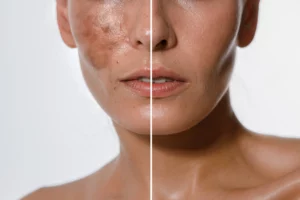
Dr Ayesha Omar recently presented a webinar for Pharmacy Magazine on Hyperpigmentation: causes & treatment made possible by Eucerin.
The webinar explored hyperpigmentation, a common skin concern affecting many South Africans, particularly women. It delved into the causes, classifications, and available treatments, emphasizing the importance of consulting a medical professional for proper diagnosis and management.
Beyond its medical implications, hyperpigmentation carries significant emotional weight, often impacting one's self-esteem and confidence. Unfortunately, in many cases, patients resort to unverified home remedies and unsafe practices, exacerbating the condition.
KEY TAKEAWAYS
- Melanin: Our skin's pigment, produced by melanocytes, determines skin, eye, and hair color. It also shields us from harmful UV rays.
- Fitzpatrick Skin Scale: Classifies skin based on sun sensitivity, with higher Fitzpatrick types (4-6) more prone to hyperpigmentation.
- Types of Hyperpigmentation:
- Epidermal (upper skin layer): Responds better to treatment, often has well-defined borders (e.g., melasma).
- Dermal (deeper skin layer): More challenging to treat, appears blurry.
- Post-inflammatory (PIH): Occurs after injury or inflammation, more common in darker skin tones.
- Causes:
- Sun exposure
- Inflammation
- Hormonal changes (pregnancy, birth control)
- Genetics
- Certain medications
- Skin conditions (eczema, lichen planus)
- Treatment options:
- Addressing the underlying cause is crucial.
- Sun protection (broad-spectrum SPF) is essential.
- Topical medications: photoprotection, hydroquinone and combinations, retinoids, ascorbic acid, azelaic acid, kojic acid, tranexamic acid, cysteamine, thiamidol.
- Chemical peels and lasers (for stubborn cases)
- Emerging pharmacological therapies include topical metformin, flutamide, thiamidol, and PRP (platelet-rich plasma). Newer non-pharmacologic options include microneedling and picosecond laser.
- Management approach dependent on cause, location, comorbidities, previous treatment history, skin type, and patient’s wish.
- Importance of managing expectations and combining therapies.
Important considerations:
- Beware of unsafe practices: Avoid unregulated creams and home remedies that can worsen hyperpigmentation.
- Consult a dermatologist: They can accurately diagnose the cause and recommend the most suitable treatment plan.
- Skin microbiome: Maintaining a balanced skin microbiome promotes overall skin health.
- Appearance: Patients of all ages can be affected by hyperpigmentation.
To watch the replay, click here.
To download Dr Omar’s presentation, click here.
To download studies on Thiamodol, click here.
Once you have watched the replay, please contact John.Woodford@newmedia.co.za to receive a certificate of attendance. Please allow 4-6 weeks for us to process your certificate, after which it will be mailed to the email address you provided during registration. Please email John.Woodford@newmedia.co.za for any queries.









